
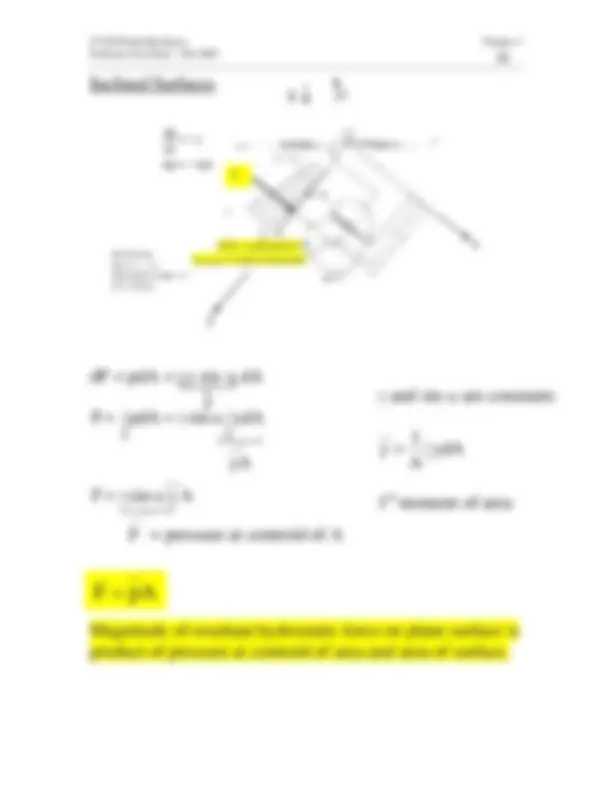
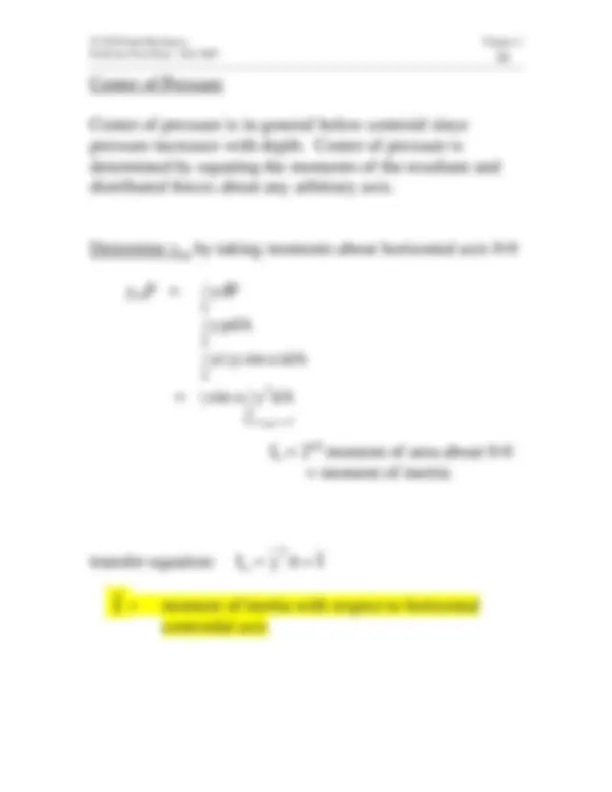
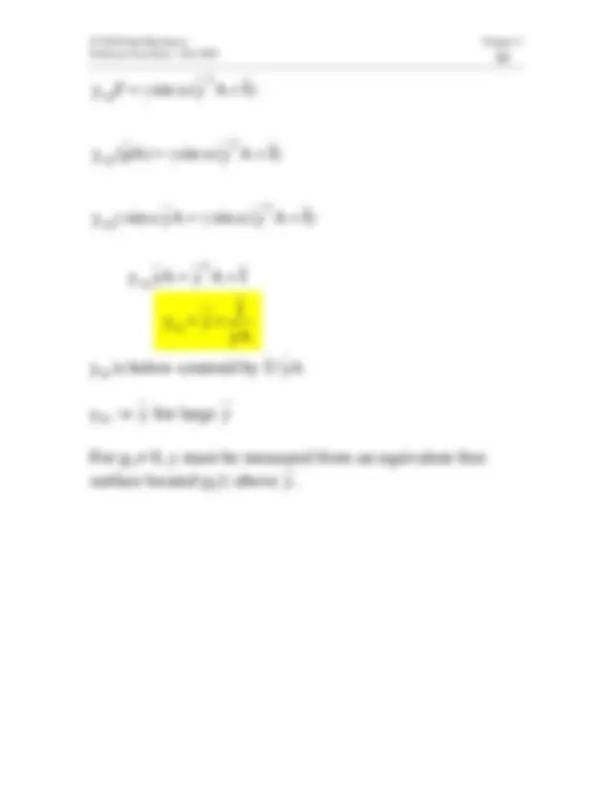
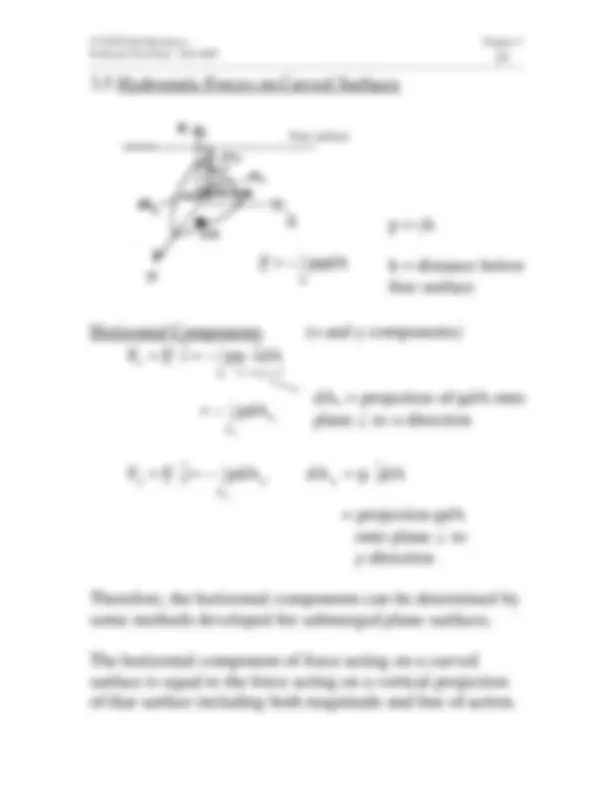
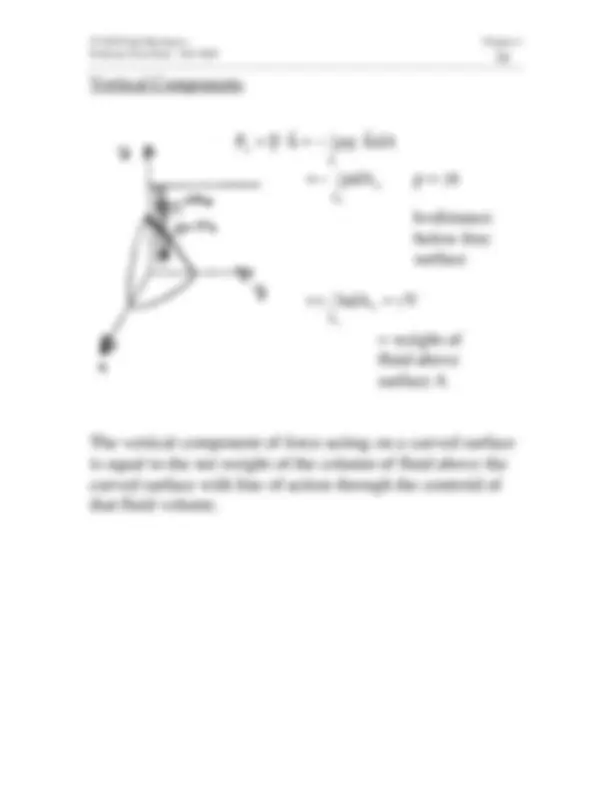
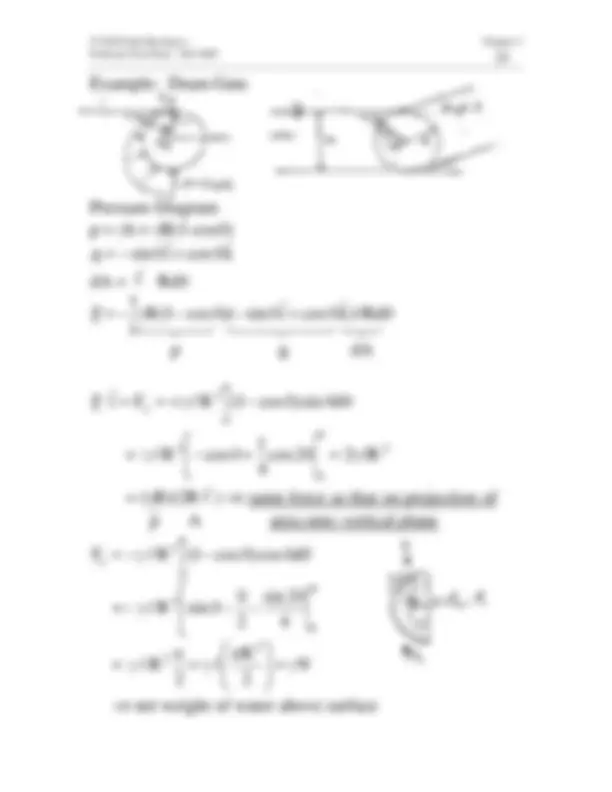
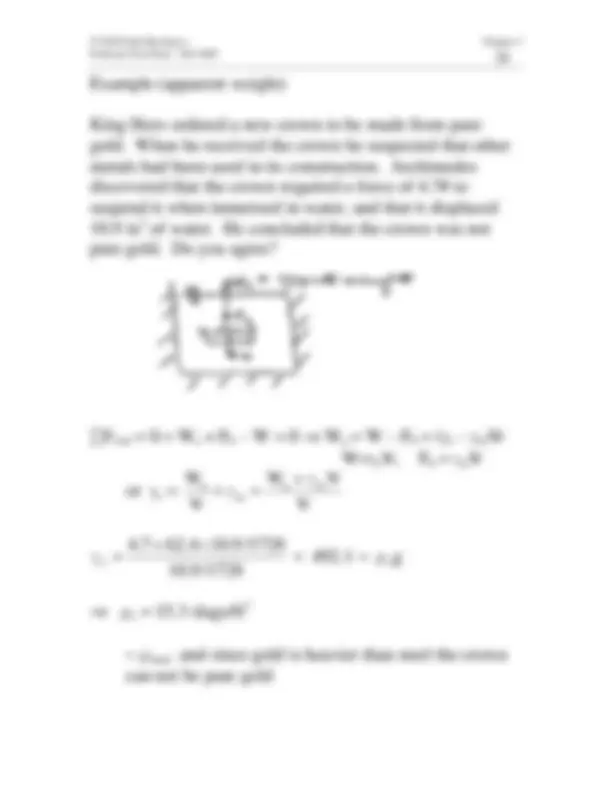
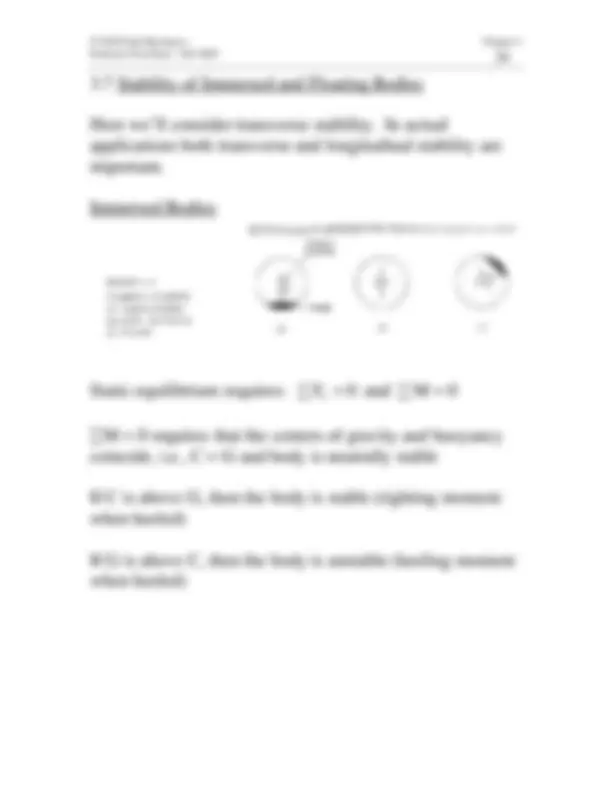

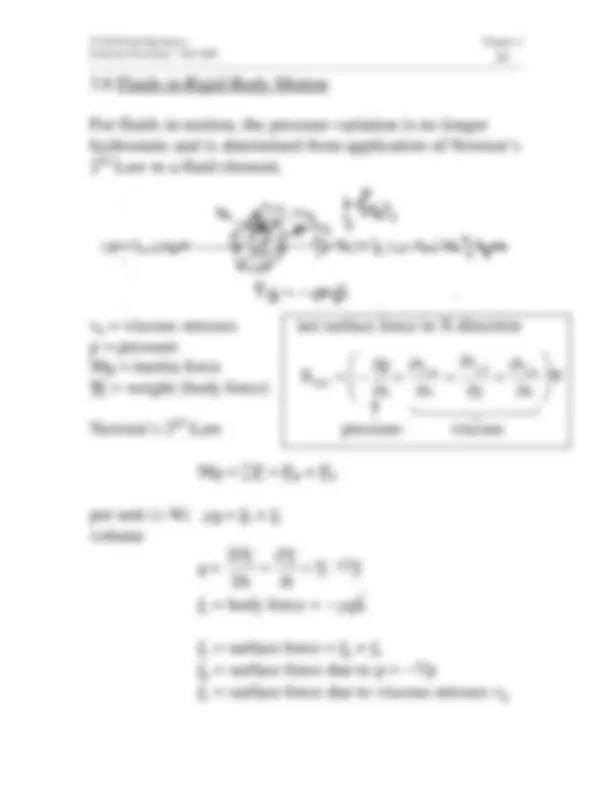
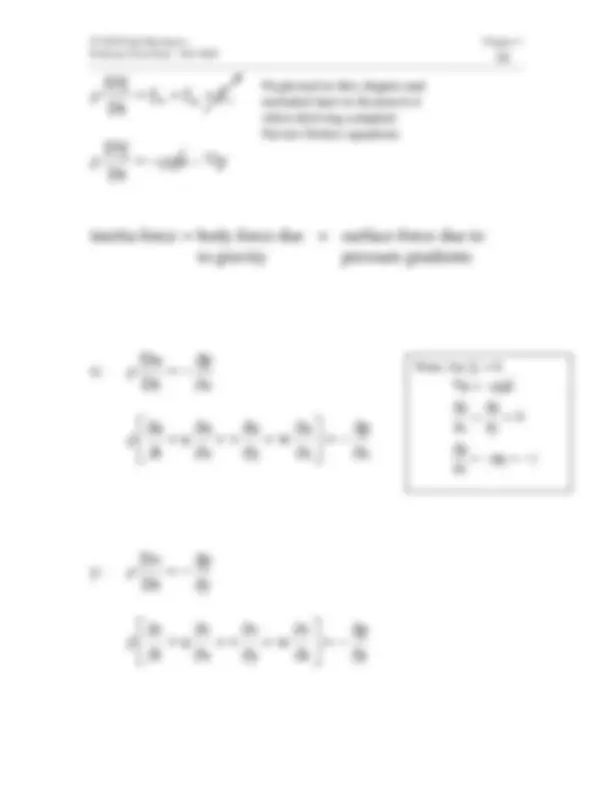
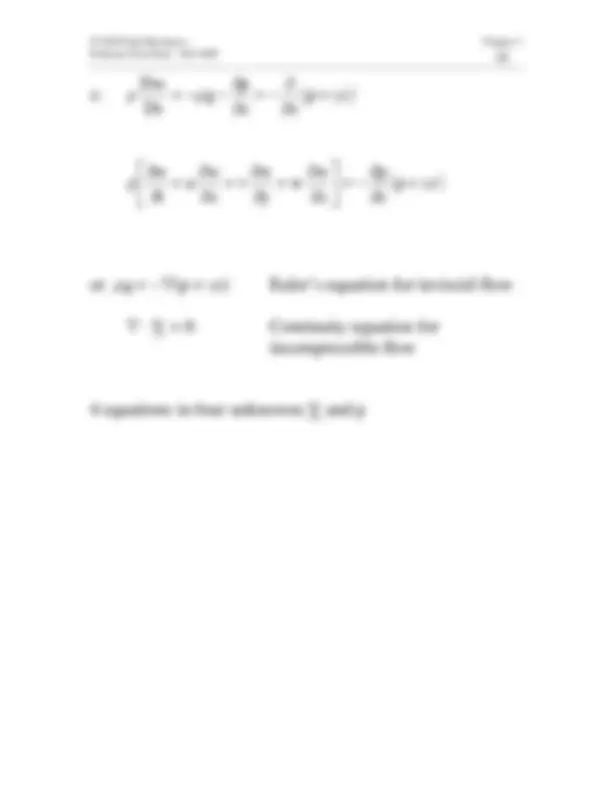
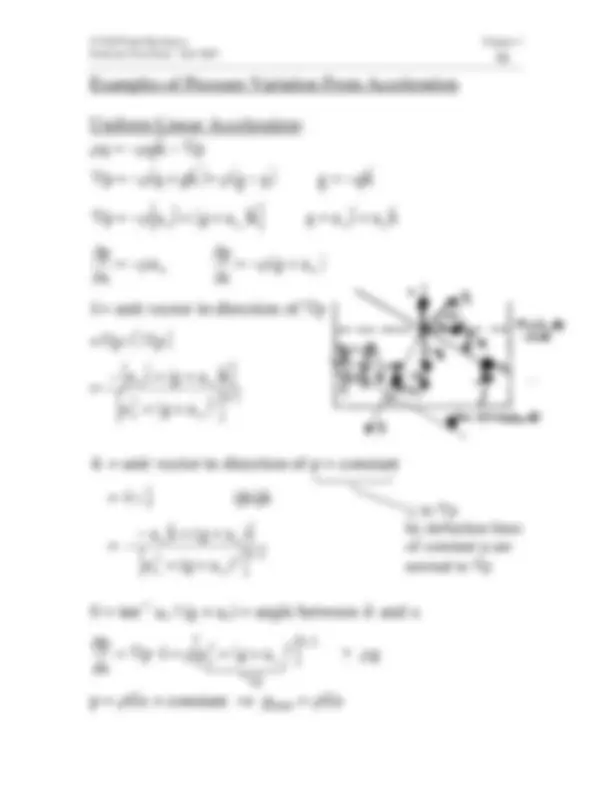
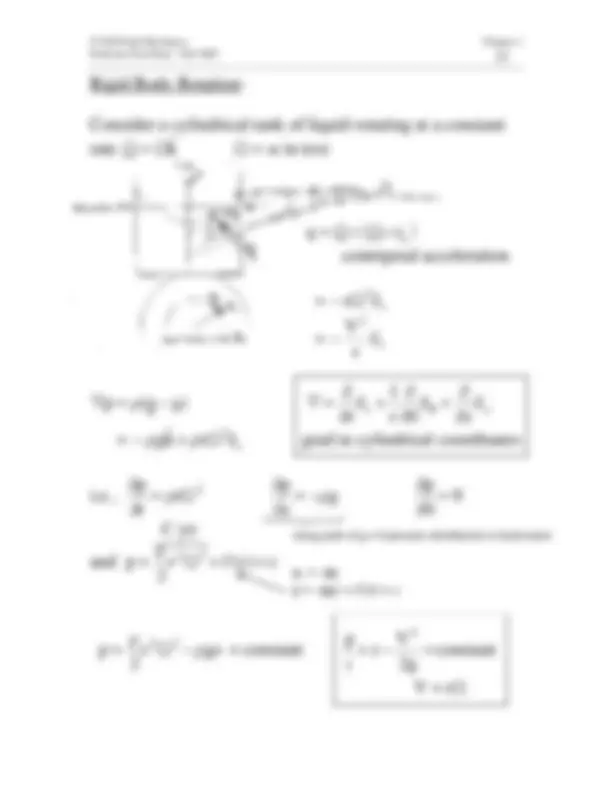
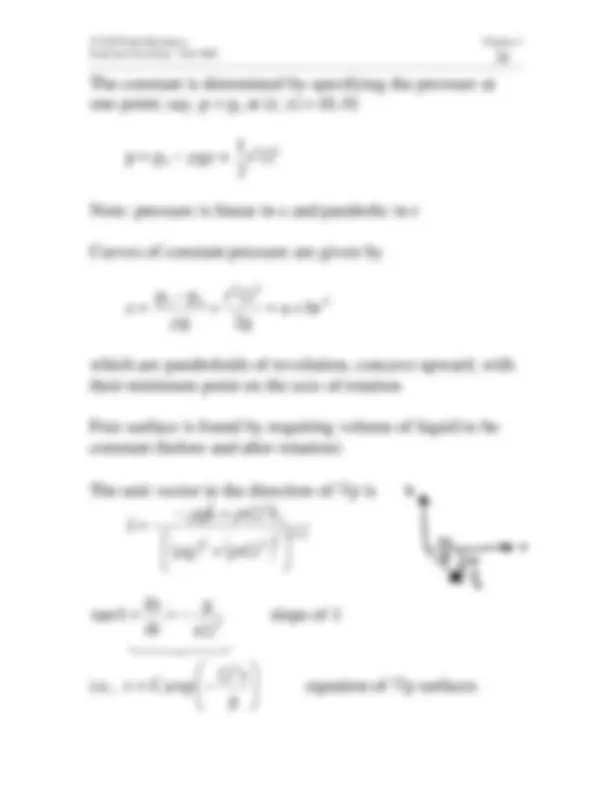
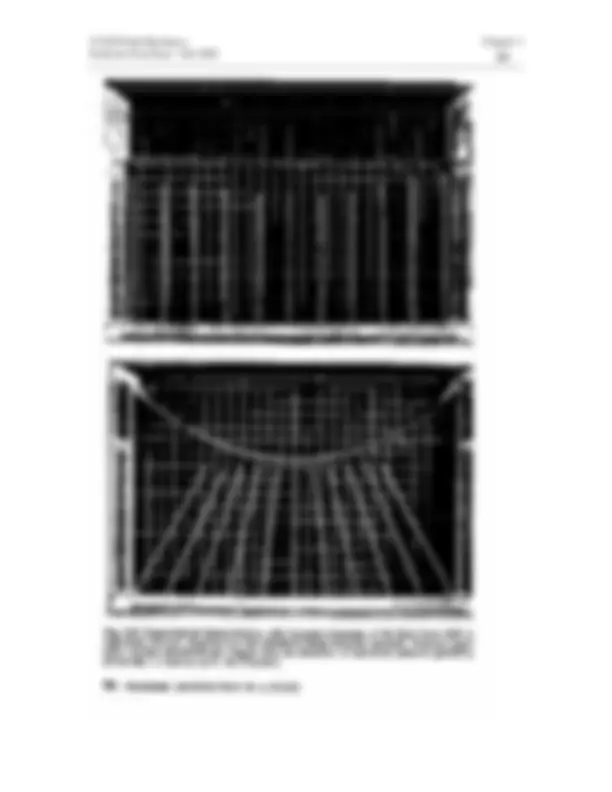


Study with the several resources on Docsity

Earn points by helping other students or get them with a premium plan


Prepare for your exams
Study with the several resources on Docsity

Earn points to download
Earn points by helping other students or get them with a premium plan
Community
Ask the community for help and clear up your study doubts
Discover the best universities in your country according to Docsity users
Free resources
Download our free guides on studying techniques, anxiety management strategies, and thesis advice from Docsity tutors
Magnitude of resultant hydrostatic force on plane surface is product of pressure at centroid of area and area of surface. Ay p = pressure at centroid of A.
Typology: Lecture notes
1 / 24

This page cannot be seen from the preview
Don't miss anything!

















Professor Fred Stern Fall 2005 (^16)
3.4 Hydrostatic Forces on Plane Surfaces
For a static fluid, the shear stress is zero and the only stress is the normal stress, i.e., pressure p. Recall that p is a scalar, which when in contact with a solid surface exerts a normal force towards the surface.
A
Fp pndA
For a plane surface n = constant such that we can separately consider the magnitude and line of action of Fp.
A
Fp F pdA
Line of action is towards and normal to A through the center of pressure (xcp, ycp).
Professor Fred Stern Fall 2005 (^17)
p = constant
Unless otherwise stated, throughout the chapter assume patm acts at liquid surface. Also, we will use gage pressure so that p = 0 at the liquid surface.
Horizontal Surfaces
F= (^) ∫ pdA=pA
Line of action is through centroid of A,
horizontal surface with area A
Professor Fred Stern Fall 2005 (^19)
Center of Pressure
Center of pressure is in general below centroid since pressure increases with depth. Center of pressure is determined by equating the moments of the resultant and distributed forces about any arbitrary axis.
Determine ycp by taking moments about horizontal axis 0-
ycpF = (^) ∫ A
ydF
∫ A
ypdA
∫ γ α A
y( ysin )dA
= γ α∫ A
sin y^2 dA
Io = 2nd^ moment of area about 0- = moment of inertia
transfer equation: I y A I
2 o = +
= moment of inertia with respect to horizontal centroidal axis
Professor Fred Stern Fall 2005 (^20)
y sin yA sin (y A I)
y (pA) sin (y A I)
y F sin (y A I)
2 cp
2 cp
2 cp
γ α =γ α +
=γ α +
=γ α +
y yA y A I
2 cp = +
ycp is below centroid by I/yA
ycp → y for large y
For po ≠ 0, y must be measured from an equivalent free
surface located po /γ above y.
cp
y y yA
Professor Fred Stern Fall 2005 (^23)
3.5 Hydrostatic Forces on Curved Surfaces
Horizontal Components (x and y components)
= ⋅ =− ∫ ⋅ A
Fx F iˆ pn iˆdA
A (^) x
pdAx
A y
Fy F ˆj pdAy dA (^) y =n⋅ˆjdA
= projection ndA onto plane ⊥ to y-direction
Therefore, the horizontal components can be determined by some methods developed for submerged plane surfaces.
The horizontal component of force acting on a curved surface is equal to the force acting on a vertical projection of that surface including both magnitude and line of action.
Free surface
A
F pndA
p = γh
h = distance below free surface
dAx = projection of ndA onto plane ⊥ to x-direction
Professor Fred Stern Fall 2005 (^25)
Example: Drum Gate
Pressure Diagram p = γh = γR(1-cosθ)
n =−sinθˆi+cosθkˆ
dA = A^ Rdθ
= − ∫ γ − θ − θ + θ θ
π
0
F R( 1 cos )( sin iˆ cos kˆ)ARd
p n dA
⋅ = =+γ ∫ − θ θ θ
π
0
2 F iˆ Fx AR ( 1 cos )sin d
0
(^2) cos 2 2 R 4
A R (^) ⎢ cos = γA ⎣
γ ⎡^ − θ+ θ
π
= (γR)(2R A^ ) ⇒ same force as that on projection of p A area onto vertical plane
= −γ ∫ − θ θ θ
π
0
2 Fz AR ( 1 cos )cos d
⎡ (^) θ −
θ −γ θ−
π
0
2 4
sin 2 2
AR sin
2 (^2) =γ ⎟⎟ ⎠
⎛ π =γ
π γ A A
⇒ net weight of water above surface
Professor Fred Stern Fall 2005 (^26)
3.6 Buoyancy
Archimedes Principle
F (^) B = F (^) v2 – F (^) v
= fluid weight above Surface 2 (ABC)
= fluid weight equivalent to body volume V
F (^) B = ρgV V = submerged volume
Line of action is through centroid of V = center of buoyancy
Net Horizontal forces are zero since F (^) BAD = F (^) BCD
Professor Fred Stern Fall 2005 (^28)
Example (apparent weight)
King Hero ordered a new crown to be made from pure gold. When he received the crown he suspected that other metals had been used in its construction. Archimedes discovered that the crown required a force of 4.7# to suspend it when immersed in water, and that it displaced 18.9 in^3 of water. He concluded that the crown was not pure gold. Do you agree?
∑Fvert = 0 = Wa + Fb – W = 0 ⇒ Wa = W – Fb = (γc - γw )V W=γcV, Fb = γw V
or γc = V
W (^) a w w
a (^) +γ = +γ
c = = ρc
γ =
⇒ ρc = 15.3 slugs/ft^3
∼ ρsteel and since gold is heavier than steel the crown can not be pure gold
Professor Fred Stern Fall 2005 (^29)
3.7 Stability of Immersed and Floating Bodies
Here we’ll consider transverse stability. In actual applications both transverse and longitudinal stability are important.
Immersed Bodies
Static equilibrium requires: (^) ∑ Fv = 0 and ∑M= 0
∑M = 0 requires that the centers of gravity and buoyancy coincide, i.e., C = G and body is neutrally stable
If C is above G, then the body is stable (righting moment when heeled)
If G is above C, then the body is unstable (heeling moment when heeled)
Professor Fred Stern Fall 2005 (^31)
Floating Bodies
α = small heel angle
x = CC′ = lateral displacement of C C = center of buoyancy i.e., centroid of displaced volume V
Solve for GM: find x using (1) basic definition for centroid of V; and (2) trigonometry Fig. 3.
(1) Basic definition of centroid of volume V
xV = (^) ∫ xdV=∑ xi ∆Vi moment about centerplane
xV = moment V before heel – moment of VAOB
x V ( x)dV xdV AOB EOD
= − (^) ∫ − + ∫ tan α = y/x
dV = ydA = x tan α dA x V x 2 tan dA x 2 tan dA AOB EOD
= (^) ∫ α + (^) ∫ α
Professor Fred Stern Fall 2005 (^32)
xV = tanα ∫x dA 2
ship waterplane area
moment of inertia of ship waterplane about z axis O-O; i.e., IOO
I (^) OO = moment of inertia of waterplane area about centerplane axis
(2) Trigonometry
= α
α ′= =
= α
CM tan V
tan I CC x
xV tan I
OO
OO
GM > 0 Stable
GM < 0 Unstable
Professor Fred Stern Fall 2005 (^34)
Dt fb^ fp fv
ρ = + +
gkˆ p Dt
ρ =−ρ −∇
inertia force = body force due + surface force due to to gravity pressure gradients
x: x
p Dt
Du ∂
ρ =−
x
p z
u w y
u v x
u u t
u ∂
ρ
y: y
p Dt
Dv ∂
ρ =−
y
p z
v w y
v v x
v u t
v ∂
ρ
Neglected in this chapter and included later in Section 6. when deriving complete Navier-Stokes equations
Note: for V = 0
=−ρ =− γ ∂
∂
= ∂
=∂ ∂
∂
∇ =−ρ
g z
p
0 y
p x
p
p gkˆ
Professor Fred Stern Fall 2005 (^35)
z z
p g Dt
Dw +γ ∂
ρ =−ρ −
z
p z
w w y
w v x
w u t
w +γ ∂
ρ
or ρa = −∇(p + γz) Euler’s equation for inviscid flow
∇ ⋅ V = 0 Continuity equation for incompressible flow
4 equations in four unknowns V and p